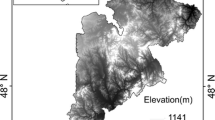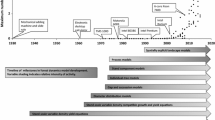Abstract
Process-based forest landscape models are valuable tools for testing basic ecological theory and for projecting how forest landscapes may respond to climate change and other environmental shifts. However, the ability of these models to accurately predict environmentally-induced shifts in species distributions as well as changes in forest composition and structure is often contingent on the phenomenological representation of individual-level processes accurately scaling-up to landscape-level community dynamics. We use a spatially explicit landscape forest model (LandClim) to examine how three alternative formulations of individual tree growth (logistic, Gompertz, and von Bertalanffy) influence model results. Interactions between growth models and landscape characteristics (landscape heterogeneity and disturbance intensity) were tested to determine in what type of landscape simulation results were most sensitive to growth model structure. We found that simulation results were robust to growth function formulation when the results were assessed at a large spatial extent (landscape) and when coarse response variables, such as total forest biomass, were examined. However, results diverged when more detailed response variables, such as species composition within elevation bands, were considered. These differences were particularly prevalent in regions that included environmental transition zones where forest composition is strongly driven by growth-dependent competition. We found that neither landscape heterogeneity nor the intensity of landscape disturbances accentuated simulation sensitivity to growth model formulation. Our results indicate that at the landscape extent, simulation results are robust, but the reliability of model results at a finer resolution depends critically on accurate tree growth functions.







Similar content being viewed by others
References
Alexandrov GA (2008) Forest growth in the light of the thermodynamic theory of ecological systems. Ecol Model 216(2):102–106
Bigler C, Veblen TT (2009) Increased early growth rates decrease longevities of conifers in subalpine forests. Oikos 118(8):1130–1138
Bolte A, Ammer C, Lof M, Madsen P, Nabuurs GJ, Schall P, Spathelf P, Rock J (2009) Adaptive forest management in central Europe: climate change impacts, strategies and integrative concept. Scand J For Res 24(6):473–482
Boyland M, Nelson J, Bunnell FL (2005) A test for robustness in harvest scheduling models. For Ecol Manag 207(1–2):121–132
Bugmann HKM (1996) A simplified forest model to study species composition along climate gradients. Ecology 77(7):2055–2074
Bugmann H (2001) A review of forest gap models. Climatic Change 51(3–4):259–305
Bugmann HKM (2003) Predicting the ecosystem effects of climate change. In: Canham CD, Lauenroth WK, Cole JS (eds) Models in ecosystem science. Princeton University Press, Princeton, pp 385–409
Coates KD (2002) Tree recruitment in gaps of various size, clearcuts and undisturbed mixed forest of interior British Columbia, Canada. For Ecol Manag 155(1–3):387–398
Colbert JJ, Schuckers M, Fekedulegn D, Rentch J, MacSiurtain M, Gottschalk K (2004) Individual tree basal-area growth parameter estimates for four models. Ecol Model 174:115–126
Druckenbrod DL, Shugart HH, Davies I (2005) Spatial pattern and process in forest stands within the Virginia piedmont. J Veg Sci 16(1):37–48
Fahey TJ, Woodbury PB, Battles JJ, Goodale CL, Hamburg SP, Ollinger SV, Woodall CW (2010) Forest carbon storage: ecology, management, and policy. Front Ecol Environ 8(5):245–252
Fahrig L (2003) Effects of habitat fragmentation on biodiversity. Annu Rev Ecol Evol Syst 34:487–515
Falkowski MJ, Hudak AT, Crookston NL, Gessler PE, Uebler EH, Smith AMS (2010) Landscape-scale parameterization of a tree-level forest growth model: a k-nearest neighbor imputation approach incorporating LiDAR data. Can J For Res-Revue Canadienne De Recherche Forestiere 40(2):184–199
Fekedulegn D, Mac Siurtain MP, Colbert JJ (1999) Parameter estimation of nonlinear growth models in forestry. Silva Fennica 33(4):327–336
Getzin S, Wiegand T, Wiegand K, He FL (2008) Heterogeneity influences spatial patterns and demographics in forest stands. J Ecol 96(4):807–820
Guisan A, Thuiller W (2005) Predicting species distribution: offering more than simple habitat models. Ecol Lett 8(9):993–1009
Hartmann H, Daoust G, Bigue B, Messier C (2010) Negative or positive effects of plantation and intensive forestry on biodiversity: a matter of scale and perspective. For Chron 86(3):354–364
He HS (2008) Forest landscape models: definitions, characterization, and classification. For Ecol Manag 254(3):484–498
He HS, Mladenoff DJ, Gustafson EJ (2002) Study of landscape change under forest harvesting and climate warming-induced fire disturbance. For Ecol Manag 155(1):257–270
He HS, Hao ZQ, Mladenoff DJ, Shao GF, Hu YM, Chang Y (2005) Simulating forest ecosystem response to climate warming incorporating spatial effects in north-eastern China. J Biogeogr 32(12):2043–2056
He HS, Keane RE, Iverson LR (2008) Forest landscape models, a tool for understanding the effect of the large-scale and long-term landscape processes. For Ecol Manag 254(3):371–374
He HS, Yang J, Shifley SR, Thompson FR (2011) Challenges of forest landscape modeling—simulating large landscapes and validating results. Landscape Urban Plan 100(4):400–402
Klenner W, Kurz W, Beukema S (2000) Habitat patterns in forested landscapes: management practices and the uncertainty associated with natural disturbances. Comput Electron Agric 27(1–3):243–262
Li MH, Yang J (2004) Effects of microsite on growth of Pinus cembra in the subalpine zone of the Austrian Alps. Ann For Sci 61(4):319–325
Li M, Yang J, Krauchi N (2003) Growth responses of Picea abies and Larix decidua to elevation in subalpine areas of Tyrol, Austria. Can J For Res-Revue Canadienne De Recherche Forestiere 33(4):653–662
Lindner M, Maroschek M, Netherer S, Kremer A, Barbati A, Garcia-Gonzalo J, Seidl R, Delzon S, Corona P, Kolström M, Lexer MJ, Marchetti M (2010) Climate change impacts, adaptive capacity, and vulnerability of European forest ecosystems. For Ecol Manag 259(4):698–709
Liu JG, Ashton PS (1995) Individual-based simulation-models for forest succession and management. For Ecol Manag 73(1–3):157–175
MacFarlane DW, Green EJ, Valentine HT (2000) Incorporating uncertainty into the parameters of a forest process model. Ecol Model 134(1):27–40
McEwan RW, Dyer JM, Pederson N (2011) Multiple interacting ecosystem drivers: toward an encompassing hypothesis of oak forest dynamics across eastern North America. Ecography 34:244–256
Netherer S, Schopf A (2010) Potential effects of climate change on insect herbivores in European forests—general aspects and the pine processionary moth as specific example. For Ecol Manag 259(4):831–838
Pacala SW, Canham CD, Saponara J, Silander JA, Kobe RK, Ribbens E (1996) Forest models defined by field measurements: estimation, error analysis and dynamics. Ecol Monogr 66(1):1–43
Pastor J, Post WM (1988) Response of northern forests to CO2-induced climate change. Nature 334(6177):55–58
Peng CH (2000) Growth and yield models for uneven-aged stands: past, present and future. For Ecol Manag 132(2–3):259–279
Radeloff VC, Mladenoff DJ, Gustafson EJ, Scheller RM, Zollner PA, He HS, Akcakaya HR (2006) Modeling forest harvesting effects on landscape pattern in the Northwest Wisconsin Pine Barrens. For Ecol Manag 236(1):113–126
Rammig A, Bebi P, Bugmann H, Fahse L (2007a) Adapting a growth equation to model tree regeneration in mountain forests. Eur J Forest Res 126(1):49–57
Rammig A, Fahse L, Bebi P, Bugmann H (2007b) Wind disturbance in mountain forests: simulating the impact of management strategies, seed supply, and ungulate browsing on forest succession. For Ecol Manag 242(2–3):142–154
Reyes GP, Kneeshaw D (2008) Moderate-severity disturbance dynamics in Abies balsamea-Betula spp. forests: the relative importance of disturbance type and local stand and site characteristics on woody vegetation response. Ecoscience 15(2):241–249
Reynolds JF, Bugmann H, Pitelka LF (2001) How much physiology is needed in forest gap models for simulating long-term vegetation response to global change? Challenges, limitations, and potentials. Climatic Change 51(3–4):541–557
Scheller RM, Mladenoff DJ (2004) A forest growth and biomass module for a landscape simulation model, LANDIS: design, validation, and application. Ecol Model 180(1):211–229
Scheller RM, Mladenoff DJ (2007) An ecological classification of forest landscape simulation models: tools and strategies for understanding broad-scale forested ecosystems. Landscape Ecol 22(4):491–505
Schmidt DA, Taylor AH, Skinner CN (2008) The influence of fuels treatment and landscape arrangement on simulated fire behavior, Southern Cascade range, California. Forest Ecology and Management 255(8–9):3170–3184
Schumacher S, Bugmann H (2006) The relative importance of climatic effects, wildfires and management for future forest landscape dynamics in the Swiss Alps. Glob Change Biol 12(8):1435–1450
Schumacher S, Bugmann H, Mladenoff DJ (2004) Improving the formulation of tree growth and succession in a spatially explicit landscape model. Ecol Model 180(1):175–194
Schumacher S, Reineking B, Sibold J, Bugmann H (2006) Modeling the impact of climate and vegetation on fire regimes in mountain landscapes. Landscape Ecol 21(4):539–554
Smith B, Prentice IC, Sykes MT (2001) Representation of vegetation dynamics in the modelling of terrestrial ecosystems: comparing two contrasting approaches within European climate space. Glob Ecol Biogeogr 10(6):621–637
Stoy PC, Katul GG, Siqueira MBS, Juang JY, Novick KA, McCarthy HR, Oishi AC, Oren R (2008) Role of vegetation in determining carbon sequestration along ecological succession in the southeastern United States. Glob Change Biol 14(6):1409–1427
Tabachnick BG, Fidell LS (2007) Using multivariate statistics. Pearson/Allyn & Bacon, Boston
Taylor AR, Chen HYH, VanDamme L (2009) A review of forest succession models and their suitability for forest management planning. For Sci 55(1):23–36
Trasobares A, Pukkala T, Muna J (2004) Growth and yield model for uneven-aged mixtures of Pinus sylvestris L. and Pinus nigra Arn. in Catalonia, north-east Spain. Ann For Sci 61(1):9–24
Urban DL, Shugart HH (1992) Individual-based models of forest succession. In: Glenn-Lewin DC, Peet RK, Veblen TT (eds) Plant succession: theory and predictions, population and community biology series. Chapmann and Hall, London, pp 249–292
Wermelinger B (2004) Ecology and management of the spruce bark beetle Ips typographus—a review of recent research. For Ecol Manag 202(1–3):67–82
Wilby RL, Schimel DS (1999) Scales of interaction in ego-hydrological relations. In: Baird AJ, Wilby RL (eds) Eco-hydrology: plants and water in terrestrial and aquatic environments, Routledge Physical Environment Series, pp 39–77
Wunder J, Brzeziecki B, Zybura H, Reineking B, Bigler C, Bugmann H (2008) Growth-mortality relationships as indicators of life-history strategies: a comparison of nine tree species in unmanaged European forests. Oikos 117(6):815–828
Xu CG, He HS, Hu YM, Chang Y, Larsen DR, Li XZ, Bu RC (2004) Assessing the effect of cell-level uncertainty on a forest landscape model simulation in northeastern China. Ecol Model 180(1):57–72
Xu CG, He HS, Hu YM, Chang Y, Li XZ, Bu RC (2005) Latin hypercube sampling and geostatistical modeling of spatial uncertainty in a spatially explicit forest landscape model simulation. Ecol Model 185(2–4):255–269
Zeide B (1993) Analysis of growth equations. For Sci 39(3):594–616
Zierl B, Bugmann H, Tague CL (2007) Water and carbon fluxes of European ecosystems: an evaluation of the ecohydrological model RHESSys. Hydrol Process 21(24):3328–3339
Author information
Authors and Affiliations
Corresponding author
Rights and permissions
About this article
Cite this article
Elkin, C., Reineking, B., Bigler, C. et al. Do small-grain processes matter for landscape scale questions? Sensitivity of a forest landscape model to the formulation of tree growth rate. Landscape Ecol 27, 697–711 (2012). https://doi.org/10.1007/s10980-012-9718-3
Received:
Accepted:
Published:
Issue Date:
DOI: https://doi.org/10.1007/s10980-012-9718-3




